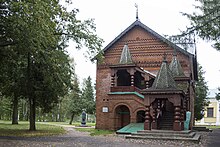Dmitry of Uglich
This article needs additional citations for verification. (January 2021) |
| Dmitry Ivanovich | |
|---|---|
| Tsarevich of Russia | |
Rurik | |
| Father | Ivan IV of Russia |
| Mother | Maria Nagaya |
| Religion | Russian Orthodox |
Dmitry of Uglich | |
|---|---|
| the Wonderworker, Slain Crown Prince or Pious Crown Prince | |
| Venerated in | Eastern Orthodox Church |
| Feast | May 15/ 28 |
Dmitry Ivanovich (Russian: Дмитрий Иванович; 29 October [O.S. 19 October] 1582 – 15 May 1591)[1] was the youngest son of Russian tsar Ivan the Terrible. He was the tsarevich (heir apparent) for close to seven years of his half-brother Feodor I's reign (though his legitimacy as an heir could have been contested by the Russian Orthodox Church). After his death, he was impersonated by a number of imposters to the throne, during the Time of Troubles.
Life
Dmitry was the youngest son of Ivan the Terrible by his last wife Maria Nagaya, and their only child together.[2] Ivan died in 1584, and was succeeded by Dmitry's older brother, Feodor I. Feodor was sickly and weak, and the country was governed by a regency council. This was headed from 1586 by Boris Godunov, Feodor's brother-in-law and Malyuta Skuratov's son-in-law.
In 1584, Godunov sent Dmitry, and his mother and her brothers, into internal exile in the tsarevich's appanage of Uglich. On 15 May 1591, Dmitry died there under mysterious circumstances.
As a result, when Feodor I died childless in 1598, Dmitry, the only other possible Rurikid heir, was also dead, and Godunov claimed the throne.
It was widely believed at the time that Godunov got rid of Dmitry to clear the way for his own eventual succession.[3]
Death theories

Russian chroniclers and later historians offered two possible scenarios of what could have happened to Dmitry. The first theory is that Dmitry was killed by order of

The second theory is that Dmitry stabbed himself in the
There is also a third version of Dmitry's fate, which found support with some earlier historians, such as
Aftermath

The death of the tsarevich roused a violent riot in
However, when the political circumstances changed, Shuisky retracted his earlier claim of accidental death and asserted that Dmitry was murdered on
Cultural references
The story of murder is presumed in
References
- ^ The name is also translated as Demetrius or transliterated in numerous other ways. See Dmitry.
- ^ Ray, Michael. "Dmitry Ivanovich". Encyclopedia Britannica
- OCLC 1289513805.)
{{cite book}}: CS1 maint: location missing publisher (link - ASIN B0007JWDNG.
- ^ "RUSSIA...Dmitry on the Blood | Travel Blog". travelblog.org. Retrieved 15 October 2020.
Bibliography
- Sergey Platonov. Очерки по истории смуты в Московском государстве XVI-XVII вв. Moscow, 1937.
- Ruslan Skrynnikov. Лихолетье. Москва в XVI-XVII веках. Moscow, 1988.
